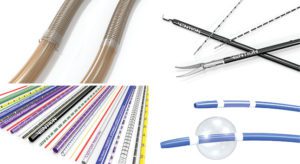Mark A. Saab/Chief Technology Officer/Vention Medical
 Ultra-thin-wall, medical-grade heat-shrink tubing is used in a variety of catheters and minimally invasive medical devices. Polyester (PET) heat-shrink tubing stands out from other heat-shrink tubing due to its ultra-thin walls, high strength and insulative properties. It is 10 to 100 times thinner than other heat-shrink tubing and more than 10 times stronger. Walls as thin as 0.00015 in. make PET heat-shrink tubing applicable to a wider range of product designs in which it is left on the product to add strength or insulation while adding little to the device dimensions. Following are key examples of these applications.
Ultra-thin-wall, medical-grade heat-shrink tubing is used in a variety of catheters and minimally invasive medical devices. Polyester (PET) heat-shrink tubing stands out from other heat-shrink tubing due to its ultra-thin walls, high strength and insulative properties. It is 10 to 100 times thinner than other heat-shrink tubing and more than 10 times stronger. Walls as thin as 0.00015 in. make PET heat-shrink tubing applicable to a wider range of product designs in which it is left on the product to add strength or insulation while adding little to the device dimensions. Following are key examples of these applications.
Variable-stiffness catheters
Because of its ultra-thin walls, PET heat-shrink tubing can add stiffness to catheters without significantly adding to the device profile. By using different thicknesses of heat-shrink tubing along the length of the catheter, you can achieve varying degrees of flexibility. For example, you could use heat-shrink tubing with a one-mil wall at the back end of a catheter, a half-mil wall in the middle, a quarter-mil wall near the end, and none at the tip for full flexibility.
Protective covering
PET heat-shrink tubing is often used to cover laser-cut hypotubes, braided catheter shafts, spring coils, and other parts that require a thin but strong outer layer. The tubing provides a smooth transition over sharp edges and can be sealed against fluid leakage.
Reinforcement
With its high hoop strength, PET heat-shrink tubing offers effective reinforcement. For balloon catheters, you can apply a narrow band of heat-shrink tubing over the end of the balloon to reinforce the bond and help to support the balloon bond during inflation. In braid-reinforced tubing, PET heat-shrink tubing can contain the braid at the end and prevent it from unraveling or poking through the thermoplastic layer.
Tube marking and printing
To add depth marks and printing to catheters and metal shafts, simply order custom-printed PET heat-shrink tubing and apply it to the product. This avoids sending the actual devices to a printer for labeling or bringing printing inks and solvents into the manufacturing facility for in-house printing.
Electrical insulation
Because of its high dielectric strength, PET heat-shrink tubing is an effective electrical insulation material that adds little dimension because of its ultra-thin walls. For example, you can use it over needles to protect the skin from being burned during electrical stimulation, or to insulate electrosurgical devices, electrical components and wiring on catheters and other devices.
These are just a few of the many applications that take advantage of the unique properties of PET heat-shrink tubing. The ultra-thin yet strong walls of this tubing make it an outstanding material for medical device designers looking for ways to make devices smaller and thinner so they can build in more features without increasing device profile.

